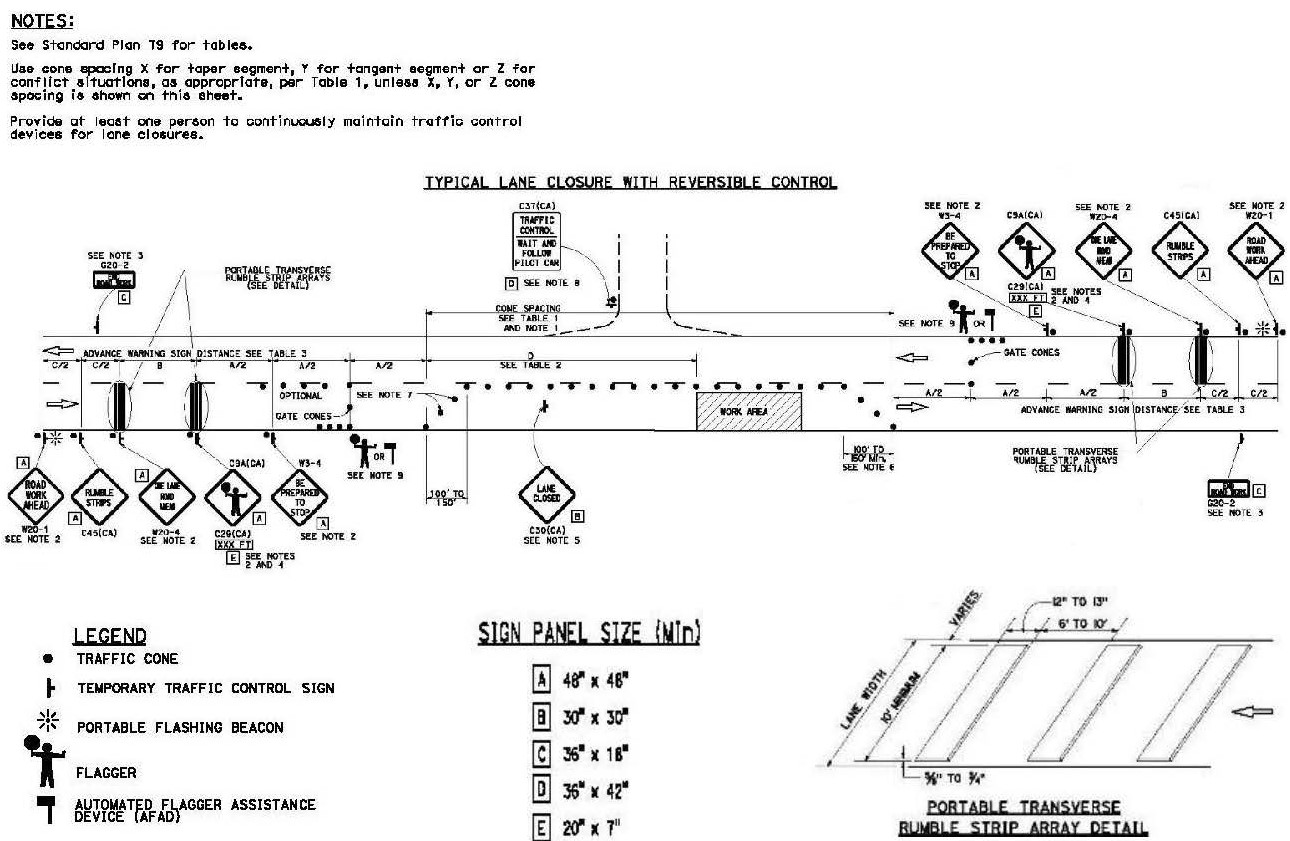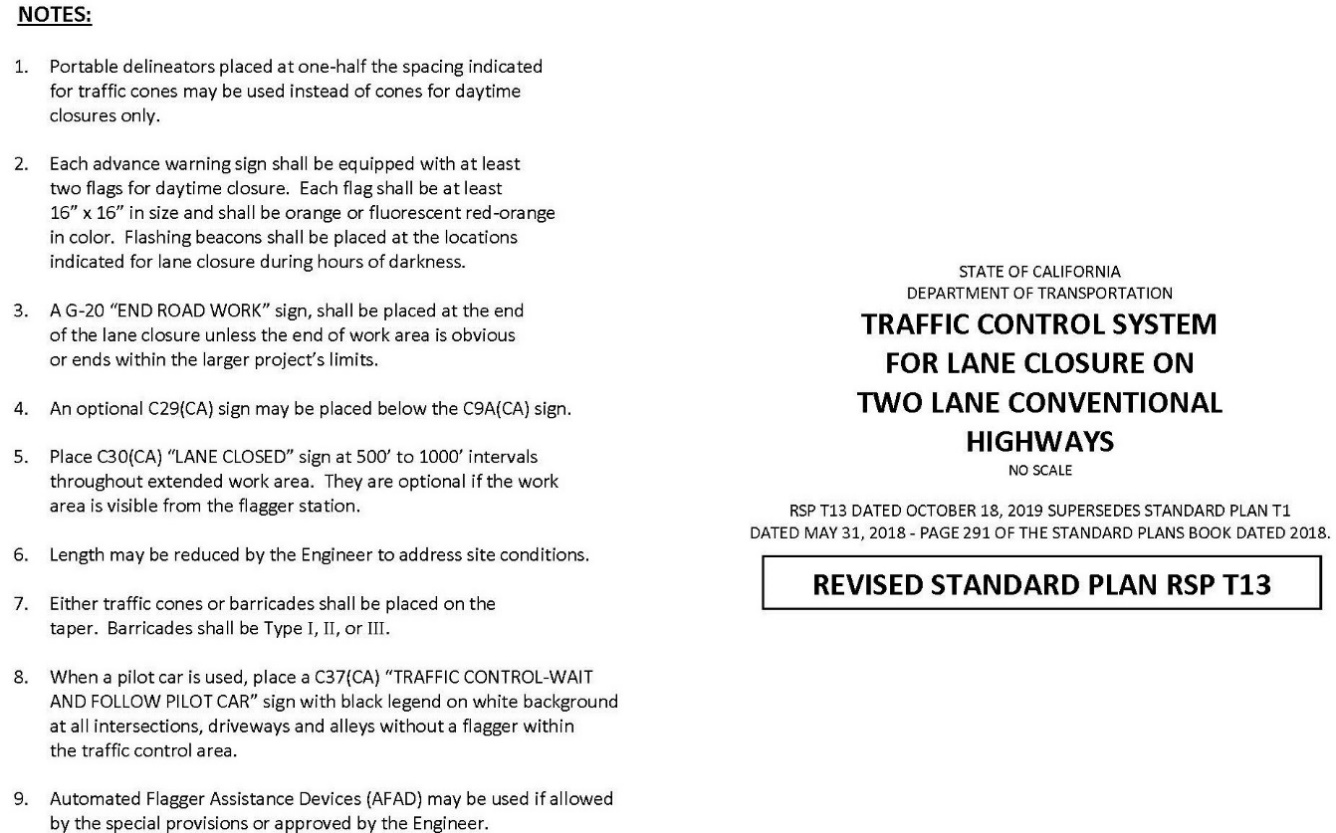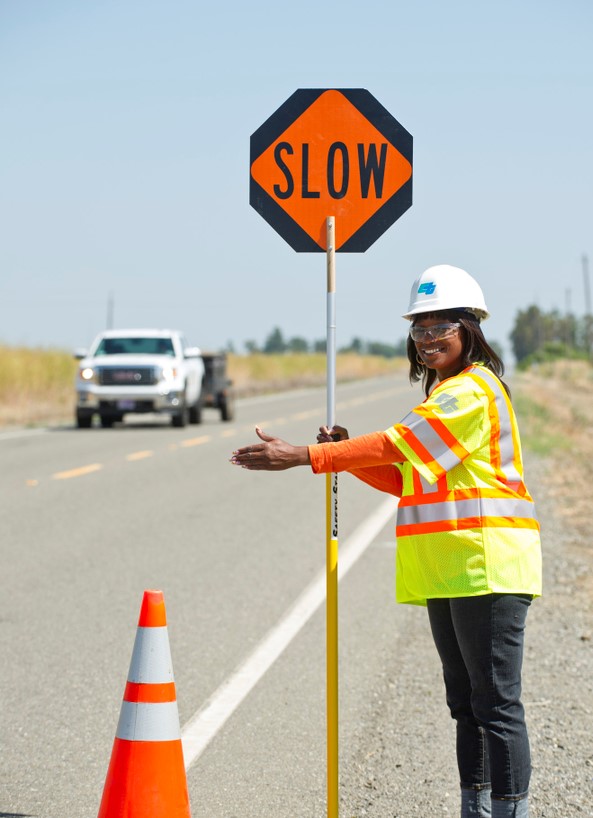Flagging Instruction Handbook
Published July 2020
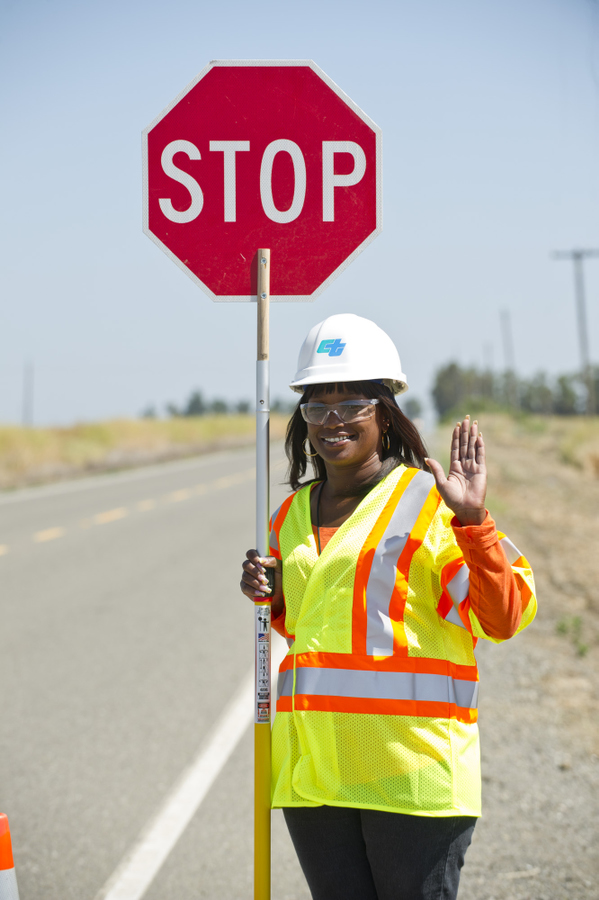
This instruction handbook is for informational purposes only
References
2018 Caltrans Standard Specifications
California Manual on
Uniform Traffic Control Devices
2014 Edition (Revision 5)
NOTE: These guidelines are for flagging operations. In this manual, the term “traffic” means vehicles, pedestrians, bicyclists, and all users of highway for the purpose of travel.
California Department of Transportation
Division of Construction
July 2020
Contents
- Flagger Basics
- Flagger Training Requirements
- Flagger Abilities
- Flagger Stations
- Location
- Rumble Strips
- Flagger Operations
- Flagging Equipment
- High-Visibility Safety Apparel
- Hand-Signaling Devices
- STOP/SLOW Paddle
- Flags
- Advance Warning Signs
- Additional Equipment
- FLAGGER PROCEDURES
- Using the Stop/Slow Paddle
- Objectives
- Procedure
- To Stop Traffic
- To Let Traffic Proceed
- To Alert and Slow Traffic
- Using Flags
- One-Lane, Two-Way Traffic Control
- Single Flagger
- Two Flaggers
- Automated Flagger Assistance Device (AFAD)
- Additional Flaggers
- Advance Flagger
- Pilot Car
- Using the Stop/Slow Paddle
- Urgent Situations
- Directing Emergency Vehicles
- Traffic Control Violations
- Traffic Accidents
- Encountering Hostile Individuals
FLAGGER BASICS
Flagger Training Requirements
Section 1599, “Flaggers” of the Construction Safety Orders (California Code of Regulations [8 CCR 1599]) requires that flaggers be trained in the fundamentals of flagging moving traffic before being assigned as flaggers. The training requirements for flaggers are included in Part 6, “Temporary Traffic Control,” of the California Manual on Uniform Traffic Control Devices.
Training must be provided by a provider with the qualifications and the experience necessary to effectively instruct the employee and must be documented as required by 8 CCR 3203, “Injury Illness and Prevention Program.”
Flaggers that are part of a traffic control system must be certified by an authorized flagger training provider. The authorized flagger training provider list is available at the Caltrans Division of Construction website: https://dot.ca.gov/programs/construction/safety-traffic/safety-training-courses
Flagger Abilities
Flaggers are responsible for public safety and for temporary traffic control. Because flaggers have frequent contact with traffic, they should demonstrate the following abilities:
- Receive and communicate specific instructions clearly, firmly, and courteously
- Move and maneuver quickly to avoid danger from errant vehicles
- Control signaling devices, such as paddles and flags, to provide clear and positive guidance to drivers approaching a temporary traffic control zone in frequently changing situations
- Use proper flagging methodology and operations
- Properly use the STOP/SLOW paddle and hand signals before being assigned as a flagger
- Understand the layout of the work zone and flagging station
- Understand and apply safe traffic-control practices, sometimes in stressful or emergency situations
- Hear, see, and recognize dangerous traffic situations and warn workers in sufficient time to avoid injury
FLAGGER STATIONS
Location
Flagger stations must be located such that the traveling public has sufficient distance to stop at an intended stopping point before entering the work space. Flagger stations should be preceded by advance warning signs. Except in emergency situations, flagger stations must be illuminated during hours of darkness with a minimum 20-foot-diameter illumination footprint (at 10 foot-candles in accordance with 8 CCR 1523) so the flagger is clearly visible to approaching traffic.
Location and visibility are important factors in flagging operations. Observe that:
- Flagger stations are at points of maximum visibility.
- Flagger stations are on the shoulder and opposite the active work area.
- Flaggers are easily identified by traffic and not confused with other workers in the area.
- C9A (CA) flagger symbols and W3-4 “BE PREPARED TO STOP” signs are covered completely, turned, or removed when flaggers are no longer needed.
- All vehicles are parked away from the flagger station.
The following chart shows the distance of flagger stations in advance of work areas.
Distance of Flagger Station in Advance of the Work Area
(2018 Standard Plan T-9)
Longitudinal Buffer Space and Flagger Station Spacing
|
SPEED (mph) |
Minimum Distance (feet |
DOWNGRADE Minimum Distance |
||
|---|---|---|---|---|
|
-3% (feet) |
-6% (feet) |
-9% (feet) |
||
|
20 |
115 |
116 |
120 |
126 |
|
25 |
155 |
158 |
165 |
173 |
|
30 |
200 |
205 |
215 |
227 |
|
35 |
250 |
257 |
271 |
287 |
|
40 |
305 |
315 |
333 |
354 |
|
45 |
360 |
378 |
400 |
427 |
|
50 |
425 |
446 |
474 |
507 |
|
55 |
495 |
520 |
553 |
593 |
|
60 |
570 |
598 |
638 |
686 |
|
65 |
645 |
682 |
728 |
785 |
|
70 |
730 |
771 |
825 |
891 |
|
75 |
820 |
866 |
927 |
1003 |
Rumble Strips
Section 12-3.36 “Portable Transverse Rumble Strips,” of the Standard Specifications requires the use of portable transverse rumble strips in conjunction with flagging operations on two-lane conventional highways.
Portable transverse rumble strips may be used to alert road users of upcoming traffic controls, speed reductions, changes change in roadway alignment, or conditions requiring a complete stop.
The contractor must develop a plan for how to place the transverse rumble strips as part of the traffic-control operations. Placement must be in accordance with Revised Standard Plan (RSP) T13 and:
- Must be used only on straight sections of roadway.
- Must not be placed through pedestrian crossings or through bike lanes.
- Must be re-adjusted if they shift or become out of alignment more than 6 inches.
Portable transverse rumble strips are not required if any one of the following conditions is met:
- Work duration is 4 hours or less.
- Posted speed limit is less than 45 mph.
- Work is of emergency nature.
- Work zone is in snow or icy weather conditions.
Flagger Operations
The flagger should stand on the shoulder next to the traffic being controlled. A flagger may only stand in the lane being used by moving traffic after traffic has stopped. The flagger should be stationed sufficiently in advance of workers to warn them, for example, with audible warning devices such as horns or whistles, of approaching danger by out-of-control vehicles.
The flagger should be clearly visible to traffic at all times and must:
- Stand alone at the flagger station. Do not allow other workers to congregate around the flagger station.
- Stay out of areas that are in shadows; do not blend with the background.
- Place personal items out of the way, so they will not distract approaching traffic or block your escape route.
- Keep the flagger station clean and organized, eliminating distractions, such as chairs, books, or personal radios.
- Not lean, sit, or lie on a vehicle.
Road conditions affect stopping distance
Stopping distances vary because of changing road and weather conditions. On an icy road, for example, a vehicle may travel four times the distance required to stop on dry pavement.
The following chart compares stopping distances for a variety of road conditions. It may be used to determine the visibility distance for traffic approaching the flagger.
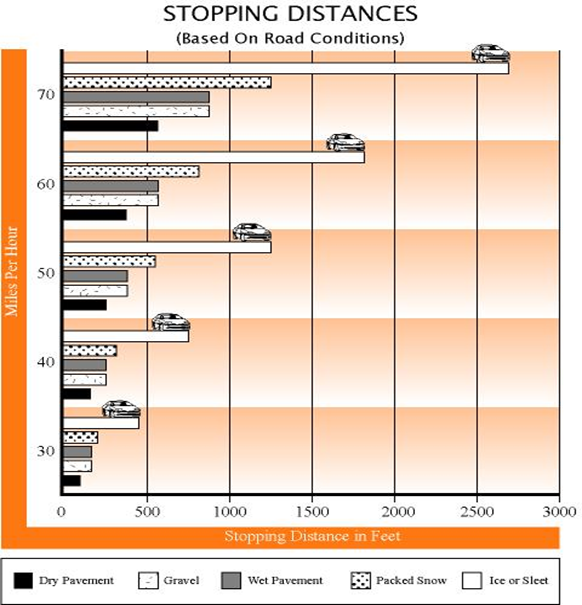
FLAGGING EQUIPMENT
High-Visibility Safety Apparel
Flaggers must wear ANSI/ISEA 107-2004 or equivalent subsequent revisions, Class 3 apparel with a material color that is either fluorescent orange-red or fluorescent yellow-green, or a combination of the two as defined in the ANSI standard. The retroreflective material must be orange, yellow, white, silver, yellow-green, or a fluorescent version of these colors and must be visible at a minimum distance of 1,000 feet.
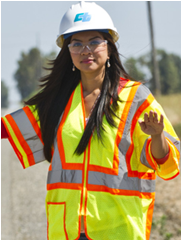
The retroreflective clothing, or the retroreflective material added to the clothing, must be designed to clearly identify the wearer as a person and must have a minimum of one horizontal stripe around the torso. High-visibility clothing must be kept clean and in good repair or replaced.
Flaggers must wear safety glasses and a white hardhat
When uniformed law enforcement officers are used to direct traffic within temporary traffic control zone, they must wear high-visibility clothing as described previously or ANSI/ISEA 207-2006 or equivalent revisions.
Hand-Signaling Devices
Hand-signaling devices, such as STOP/SLOW paddles or lights, and red flags, are used to control the vehicles through temporary traffic control zones, and must be visible to the first approaching driver at all times.
STOP/SLOW Paddle

The STOP/SLOW paddle is the primary and preferred hand-signaling device. The STOP/SLOW paddle must have an octagonal shape on a rigid handle. STOP/SLOW paddles must be at least 24-by-24 inches with letters at least 8 inches high and should be fabricated from light, semi-rigid material. The background of the STOP face must be red or fluorescent red with white letters and border. The background of the SLOW face must be orange or fluorescent orange with black letters and border. When used at night, the STOP/SLOW paddle must be retroreflective.
The STOP/SLOW paddle may be modified to improve visibility by incorporating red flashing lights on the STOP face, and yellow flashing lights on the SLOW face. Two lights may be installed and centered vertically above and below the STOP/SLOW legend, or centered horizontally on each side of the STOP/SLOW legend. Instead of two-light arrangements, a single light may be centered below the STOP/SLOW legend.
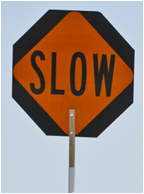
The STOP/SLOW paddle must be used with a rigid staff tall enough that when the end of the staff is resting on the ground, the bottom of the STOP/SLOW paddle is a minimum of 6 feet above the pavement.
Flags

Flags must only be used in emergency situations and only until a STOP/SLOW paddle is available.
Flags must be a minimum 24 inches square, made of a good grade red material, and securely fastened to a staff that is approximately 36 inches long. The free edge of a flag should be weighted so the flag will hang vertically, even in heavy winds. Flags must be retroreflective when used at night.
Advance Warning Signs
Each advance warning sign in each direction of travel must be equipped with at least two flags for daytime closures. Each flag must be at least 16- by-16 inches and must be orange or fluorescent red-orange. Flashing beacons must be placed at the locations indicated for lane closures during hours of darkness.
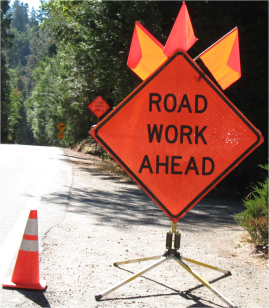
Additional Equipment
Additional flagger equipment includes: channelizing devices, such as cones; a method of communication, such as 2-way radios and other auditory warning devices as needed; drinking water; and protective clothing in case of a change in weather.
FLAGGER PROCEDURES
Using the Stop/Slow Paddle
The STOP/SLOW paddle is the primary and preferred hand-signaling device because it gives the public more positive guidance than red flags. Use of hand signaling with red flags is limited to emergency situations.
Each signal with the STOP/SLOW paddle is three parts: the message shown on the paddle, the flagger’s gesture with the free hand, and the position taken by the flagger.
Objectives
- To tell drivers what actions to take
- To be understood by drivers
- To take the guesswork out of the communication by using standard hand and paddle signals
Procedure
- When a flagger is used only to slow traffic, use the SLOW side of the paddle, and the word STOP should be covered.
- The STOP/SLOW paddle must always be held by the flagger, never placed in a traffic cone or on a barricade and never used from inside a vehicle.
The following methods of signaling with STOP/SLOW paddles must be used.
To Stop Traffic
To stop traffic, face traffic and aim the STOP paddle face toward traffic in a stationary position with the arm extended horizontally away from the body. Hold the free arm with the palm of the hand above shoulder level toward approaching traffic.
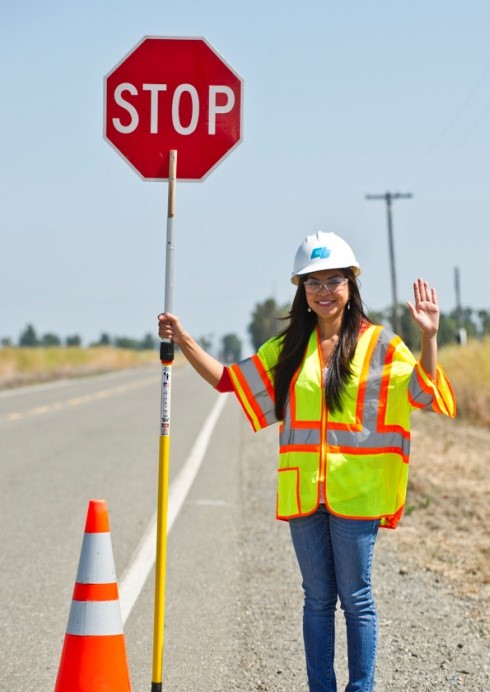
To Let Traffic Proceed
To direct traffic to proceed after stopping, face traffic with the SLOW paddle face aimed toward traffic in a stationary position with the arm extended horizontally away from the body. Motion with the free hand for traffic to proceed, moving arm in a sweeping gesture, and ending by pointing to the lane traffic is to use.
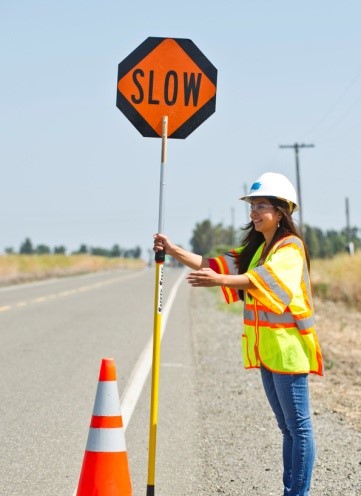
To Alert and Slow Traffic
To alert or slow traffic, face traffic with the SLOW paddle face aimed toward traffic in a stationary position with the arm extended horizontally away from the body. To further alert or slow traffic, holding the SLOW paddle face toward traffic, with the free arm outstretched and palm down, move arm up and down in a pumping motion.
Using Flags
Flags Must Be Limited to an Emergency
The following methods of signaling with a flag must be used:
To stop traffic, face traffic and extend the flag staff horizontally across the traffic lane in a stationary position so that the full area of the flag is visibly hanging below the staff. Hold the free arm with the palm of the hand higher than shoulder level toward approaching traffic.
To direct stopped traffic to proceed, stand parallel to the traffic movement and with the flag and arm lowered from the view of the traffic, motion with the free hand for traffic to proceed. Flags must not be used to signal traffic to proceed.
To alert or slow traffic, face traffic and slowly wave the flag in a sweeping motion of the extended arm from shoulder level to straight down without raising the arm above a horizontal position. Keep the free hand down.
One-Lane, Two-Way Traffic Control
One-way traffic control is typically handled by a single flagger at each end of the work zone. A pilot car may be used with flaggers to guide traffic through work zones. At spot location lane closures where adequate sight distance is available for the safe handling of traffic, one flagger may be appropriate.
Single Flagger
- Stationed on the shoulder opposite the construction zone, or in a position where good visibility and traffic control can be maintained at all times.
- When a one-lane, two-way temporary traffic control zone is short enough to allow a flagger to see from one end of the zone to the other.
- When traffic is normally light to avoid the possibility of opposing traffic arriving at the traffic control zone at the same time.
Two Flaggers
- One should be designated as the flagging coordinator.
- They should be able to communicate with each other orally, electronically, or with manual signals that cannot be mistaken for flagging signals.
Automated Flagger Assistance Device (AFAD)
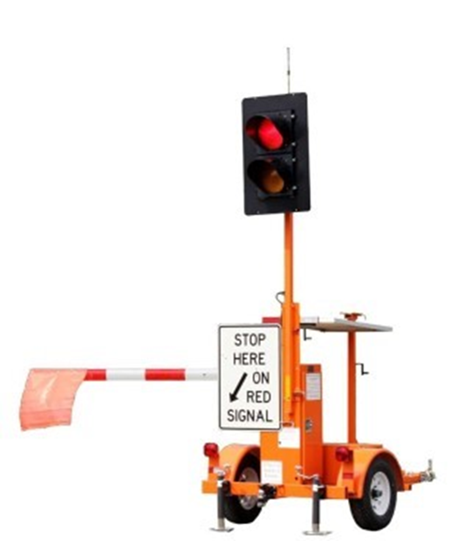
The AFAD is an automated flagging device operated by a flagger located off the roadway and away from traffic. The device is essentially an extension of the flagger’s arm. Flaggers use a remote control instead of a SLOW/STOP paddle to control the movements of traffic. The device is considered a safety enhancement for projects that use reversible temporary traffic control because it minimizes flaggers' direct exposure to traffic by allowing them to control traffic from an area away from the traveled way.
- Operator must be a certified flagger and must be certified by the manufacturer to operate the specific automated flagger assistance device.
- Remotely operated by one operator at a central location or by separate operators near each device location. When using a single operator, the AFADs must be located so the operator can see both devices.
- AFADs must be located such that approaching road users will have sufficient distance to be able to stop at the intended stopping point.
- AFAD trailers are to be placed on the roadway shoulder. There must be a minimum shoulder width of 4 feet and approximately 3 feet of adjacent level area available next to the shoulder to place a trailer mounted AFAD.
- Placement of the AFAD must not impair access for pedestrians and bicycles, if that is the case, make provisions for alternate access.
- The AFAD gate arm must not extend into the opposite lane.
- 4 to 6 cones may be placed on the lane line approaching the flagging station to address vehicles crossing over to go around the AFAD.
Additional Flaggers
Additional flaggers control the flow of traffic at intermediate locations within the limits of a closure with reversible control, at intersections, driveways and other traffic merging points.
- If there are high volume roadway intersections or driveways within the reversible traffic control construction zone, additional flaggers may be needed to control traffic entering the temporary traffic control zone from the roadway intersection.
- Use “WAIT FOR PILOT CAR” (C37[CA]) sign on barricade to close low-volume access points. Visit property owners and residents to notify them of the changes in traffic control and what they should do when exiting their driveways.
- Hold traffic at access point until the pilot vehicle arrives.
- Tell drivers what actions to take based on direction they intend to travel.
Advance Flagger
- Advanced flaggers are positioned in advance of the traffic control system and warn approaching traffic of road work ahead and potentially stopped traffic within the advance warning signs.
- Consider using an advance flagger where there is limited sight distance to the work activity area or where long queues of traffic form.
- Advance flaggers are typically stationed at the end of a section of straight roadway to maximize visibility.
- Advance flaggers are used only to slow traffic using the SLOW side of the paddle, and the word STOP must be covered.
Pilot Car
- All traffic waits for the pilot car.
- Pilot cars guide vehicles through the temporary traffic control zone or detour.
- Two or more pilot cars may guide two-way traffic through a particularly complex detour.
- The contractor’s or contracting authority’s name should be prominently displayed.
- The PILOT CAR FOLLOW ME (G20-4) or PILOT CAR DO NOT PASS (R115[CA]) sign must be prominently mounted on the rear of the vehicle.
Urgent Situations
Flaggers must know how to handle emergency flagging operations, traffic control violations, accidents in traffic control zones, and hostile individuals.
Directing Emergency Vehicles
- When informed in advance of an approaching emergency vehicle, clear an unimpeded path for the emergency vehicle by stopping traffic from all directions.
- When no notice is given, first stop the emergency vehicle and then stop all traffic, including construction equipment, to provide a clear path for the emergency vehicle to pass.
- When the type of work, such as blasting or excavation, makes the roadway impassable, advance arrangements should be made with the local police agency that has jurisdiction over the roadway.
Traffic Control Violations
- Warn construction workers, either visually or with an audible warning device, when a driver has run the flagger station.
- Stop all vehicles entering the work area, but do not put yourself in an unsafe situation.
- Be prepared for these possibilities.
- Plan your escape route in case of an emergency.
Traffic Accidents
- Notify your supervisor and call for help.
- If accidents happen in waiting traffic, stay at your station and continue to control traffic until you receive instructions from your supervisor or a police officer.
- If an accident happens within the controlled area, stop approaching traffic and follow instructions from your supervisor, the flagging coordinator or from a police officer.
- Flaggers must communicate with each other before releasing or stopping traffic.
Encountering Hostile Individuals
- Be courteous and professional.
- Do not argue with motorists, bicyclists or pedestrians.
- If a motorist fails to follow your instructions and threatens the safety of the work area, note the vehicle license number, description of vehicle, and driver.
- Report the information to your supervisor for the purpose of filing a police report.
